-
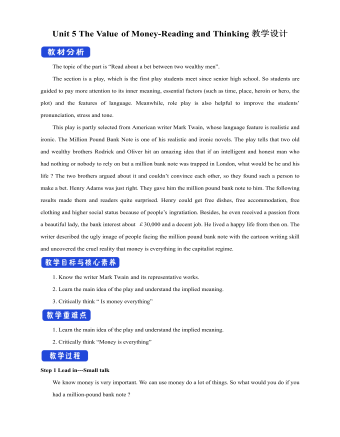
新人教版高中英语必修3Unit 5 The Value of Money-Reading and Thinking教学设计一
Everybody wants to get wealth.In today’s material world,making money or becoming wealthy symbolizes a person’s success and capability. Many people just make every effort, pay any price to attain greater wealth. With money,they can buy nice, large apartments in nice neighborhood. With money they can own luxurious cars. Wealth seems to bring all happiness in life.But is wealth the only road to happiness? Not really. There are many things in the world, which are beyond the means of money, such as friendship, love, health and knowledge. People are so preoccupied with struggling for money that they have no time or would not take the time to form or maintain friendship. What happiness can they feel living as lonely miserable creatures without love or friends in the world even if they accumulate tremendous wealth?In my opinion, people can’t do anything without money, but money is not everything. What money will bring you depends on your personal belief and goal in life. If you are kind enough to help others, especially the poor, money is a good thing to you. With it, you can do much more for the benefit of people and your country, and it will add to your own happiness. If you want money just for your own needs, you’ll never be satisfied or happy. In a word,you should have money spent for more people. Only then can money be the source of your happiness.Step 8 Homework4 students in a group, one acts Roderick, one Oliver, one servant and the fourth one acts Henry Adams, then listen to the tape, pay more attention to the difference between American English and British English in pronunciation, stress, tone.

新人教版高中英语必修3Unit 5 The Value of Money-Reading for Writing教学设计二
2. 您能看到, 我头发太长了。You can see that my hair is much too long.3. 无论什么时候, 只要您想回来就回来。Please come back whenever you want.4. 您仅有很少的头发要理! You only have too little hair to cut !5. 为您服务是我的荣幸!It is my honour to serve you!Step 9 Writing(Henry is walking down the street when he sees a sign for a place that cuts hair. He decides to have it cut. )H=Henry B=BarberH: Good afternoon, I’d like to have my hair cut, if I may. (The barber looks at Henry’s hair and continues cutting another man’s hair. ) Er, I’d really like a haircut. As you can see it’s much too long. B: (in a rude manner) Yes, I can see that. Indeed, I can. H: Fine, well, I’ll have a seat then. (He sits in one of the barber’s chairs. The barber turns to look at Henry. )B: It’s quite expensive here, you know! Are you sure you can afford it?H: Yes. I think so. (After his hair is cut, the barber tells Henry how much he must pay. Henry shows the barber the bank note. )B: Why Mr. . . (looks shocked)H: Adams. Henry Adams. I’m sorry. I don’t have any change. B: Please don’t worry! (wearing a big smile) Nothing to worry about! Nothing at all! Please come back whenever you want, even if you only have too little hair to cut! It will be my honour to serve you!Step 10 Pair workExchange drafts with a partner. Use this checklist to help your partner revise his/her draft.1. Are all the elements of a play included and in good order ?2. Do the character use suitable language ?3. Are the stage directions clear and useful ?4. Is the plot clear and exciting enough ?

新人教版高中英语必修3Unit 5 the value of money-Reading For Writing教学设计一
【参考范文】Narrator:(Henry is smiling as he leaves the restaurant. As he is walking down the street, he sees a sign for a place that cuts hair. He decides to get it cut. )H=Henry;B=Barber;R=rude manH:Good afternoon, I'd like to get a cut, if I may. (The barber looks at Henry's hair and continues cutting another man's hair. )Er, I'd really like a haircut. As you can see it's much too long. B:(in a rude manner) Yes, I can see that. Indeed, I can. H:Fine, well I'll have a seat then. (He sits in one of the barber's chairs. The barber turns to look at Henry. )B:It's quite expensive here, you know!Are you sure you can afford it?H:Yes. I think so. (In comes the rude man. )R:Hey you there. I need a haircut quickly. Can you do me straightaway?B:All right, then, get in the chair and I'll see what I can do. R:Thank you. (sits down in one of the barber's chairs)H:Excuse me, but I was here first. Aren't you going to do my hair first?B:This man's in a hurry. H:Well so am I!I insist that you cut my hair first. B:OK, but I'll have to be quick. This gentleman is waiting. H:Thank you. (They both become quiet. After his hair is cut, the barber tells Henry how much he must pay. Henry shows the barber the bank note. )B:Why, Mr . . . (looks shocked)H:Adams. Henry Adams. I'm sorry, I don't have any change. R:You're that Mr Adams! Well,I'm glad I waited or I might never have known it was you. B:Why, Mr Adams, please don't worry!(wearing a big smile) Nothing to worry about!Nothing at all!Please come back any time, even if you only need too little hairs cut!It will be my honour to serve you!

新人教版高中英语选修2Unit 1 Science and Scientists-Discovering useful structures教学设计
The grammatical structure of this unit is predicative clause. Like object clause and subject clause, predicative clause is one of Nominal Clauses. The leading words of predicative clauses are that, what, how, what, where, as if, because, etc.The design of teaching activities aims to guide students to perceive the structural features of predicative clauses and think about their ideographic functions. Beyond that, students should be guided to use this grammar in the context apporpriately and flexibly.1. Enable the Ss to master the usage of the predicative clauses in this unit.2. Enable the Ss to use the predicative patterns flexibly.3. Train the Ss to apply some skills by doing the relevant exercises.1.Guide students to perceive the structural features of predicative clauses and think about their ideographic functions.2.Strengthen students' ability of using predicative clauses in context, but also cultivate their ability of text analysis and logical reasoning competence.Step1: Underline all the examples in the reading passage, where noun clauses are used as the predicative. Then state their meaning and functions.1) One theory was that bad air caused the disease.2) Another theory was that cholera was caused by an infection from germs in food or water.3) The truth was that the water from the Broad Street had been infected by waste.Sum up the rules of grammar:1. 以上黑体部分在句中作表语。2. 句1、2、3中的that在从句中不作成分,只起连接作用。 Step2: Review the basic components of predicative clauses1.Definition

新人教版高中英语选修2Unit 4 Journey Across a Vast Land教学设计
当孩子们由父母陪同时,他们才被允许进入这个运动场。3.过去分词(短语)作状语时的几种特殊情况(1)过去分词(短语)在句中作时间、条件、原因、让步状语时,相当于对应的时间、条件、原因及让步状语从句。Seen from the top of the mountain (=When it is seen from the top of the mountain), the whole town looks more beautiful.从山顶上看,整个城市看起来更美了。Given ten more minutes (=If we are given ten more minutes), we will finish the work perfectly.如果多给十分钟,我们会完美地完成这项工作。Greatly touched by his words (=Because she was greatly touched by his words), she was full of tears.由于被他的话深深地感动,她满眼泪花。Warned of the storm (=Though they were warned of the storm), the farmers were still working on the farm.尽管被警告了风暴的到来,但农民们仍在农场干活。(2)过去分词(短语)在句中作伴随、方式等状语时,可改为句子的并列谓语或改为并列分句。The teacher came into the room, followed by two students (=and was followed by two students).后面跟着两个学生,老师走进了房间。He spent the whole afternoon, accompanied by his mom(=and was accompanied by his mom).他由母亲陪着度过了一整个下午。

新人教版高中英语选修2Unit 1 Science and Scientists-Learning about Language教学设计
Step 7: complete the discourse according to the grammar rules.Cholera used to be one of the most 1.__________ (fear) diseases in the world. In the early 19th century, _2_________ an outbreak of cholera hit Europe, millions of people died. But neither its cause, 3__________ its cure was understood. A British doctor, John Snow, wanted to solve the problem and he knew that cholera would not be controlled _4_________ its cause was found. In general, there were two contradictory theories 5 __________ explained how cholera spread. The first suggested that bad air caused the disease. The second was that cholera was caused by an _6_________(infect) from germs in food or water. John Snow thought that the second theory was correct but he needed proof. So when another outbreak of cholera hit London in 1854, he began to investigate. Later, with all the evidence he _7_________ (gather), John Snow was able to announce that the pump water carried cholera germs. Therefore, he had the handle of the pump _8_________ (remove) so that it couldn't be used. Through his intervention,the disease was stopped in its tracks. What is more, John Snow found that some companies sold water from the River Thames that __9__________________ (pollute) by raw waste. The people who drank this water were much more likely _10_________ (get) cholera than those who drank pure or boiled water. Through John Snow's efforts, the _11_________ (threaten) of cholera around the world saw a substantial increase. Keys: 1.feared 2.when 3. nor 4.unless 5.that/which 6.infection 7.had gathered 8.removed 9.was polluted 10.to get 11. threat

新人教版高中英语选修2Unit 1 Science and Scientists-Reading and thinking教学设计
Step 5: After learning the text, discuss with your peers about the following questions:1.John Snow believed Idea 2 was right. How did he finally prove it?2. Do you think John Snow would have solved this problem without the map?3. Cholera is a 19th century disease. What disease do you think is similar to cholera today?SARS and Covid-19 because they are both deadly and fatally infectious, have an unknown cause and need serious public health care to solve them urgently.keys:1. John Snow finally proved his idea because he found an outbreak that was clearly related to cholera, collected information and was able to tie cases outside the area to the polluted water.2. No. The map helped John Snow organize his ideas. He was able to identify those households that had had many deaths and check their water-drinking habits. He identified those houses that had had no deaths and surveyed their drinking habits. The evidence clearly pointed to the polluted water being the cause.3. SARS and Covid-19 because they are both deadly and fatally infectious, have an unknown cause and need serious public health care to solve them urgently.Step 6: Consolidate what you have learned by filling in the blanks:John Snow was a well-known _1___ in London in the _2__ century. He wanted to find the _3_____ of cholera in order to help people ___4_____ it. In 1854 when a cholera __5__ London, he began to gather information. He ___6__ on a map ___7___ all the dead people had lived and he found that many people who had ___8____ (drink) the dirty water from the __9____ died. So he decided that the polluted water ___10____ cholera. He suggested that the ___11__ of all water supplies should be _12______ and new methods of dealing with ____13___ water be found. Finally, “King Cholera” was __14_____.Keys: 1. doctor 2. 19th 3.cause 4.infected with 5.hit 6.marked 7.where 8.drunk 9.pump 10.carried 11.source 12.examined 13.polluted 14.defeatedHomework: Retell the text after class and preview its language points

新人教版高中英语选修2Unit 1 Science and Scientists-Using langauge教学设计
This happens because the dish soap molecules have a strong negative charge, and the milk molecules have a strong positive charge. Like magnets, these molecules are attracted to each other, and so they appear to move around on the plate, taking the food coloring with them, making it look like the colors are quickly moving to escape from the soap.Listening text:? Judy: Oh, I'm so sorry that you were ill and couldn't come with us on our field trip. How are you feeling now? Better?? Bill: Much better, thanks. But how was it?? Judy: Wonderful! I especially liked an area of the museum called Light Games.it was really cool. They had a hall of mirrors where I could see myself reflected thousands of times!? Bill: A hall of mirrors can be a lot of fun. What else did they have?? Judy: Well, they had an experiment where we looked at a blue screen for a while, and then suddenly we could see tiny bright lights moving around on it. You'll never guess what those bright lights were!? Bill: Come on, tell me!? Judy: They were our own blood cells. For some reason, our eyes play tricks on us when we look at a blue screen, and we can see our own blood cells moving around like little lights! But there was another thing I liked better. I stood in front of a white light, and it cast different shadows of me in every color of the rainbow!? Bill: Oh, I wish I had been there. Tell me more!? Judy: Well, they had another area for sound. They had a giant piano keyboard that you could use your feet to play. But then, instead of playing the sounds of a piano, it played the voices of classical singers! Then they had a giant dish, and when you spoke into it, it reflected the sound back and made it louder. You could use it to speak in a whisper to someone 17 meters away.? Bill: It all sounds so cool. I wish I could have gone with you? Judy: I know, but we can go together this weekend. I'd love to go there again!? Bill: That sounds like a great idea!

新人教版高中英语选修2Unit 2 Bridging Cultures-Discovering useful structures教学设计
The grammar of this unit is designed to review noun clauses. Sentences that use nouns in a sentence are called noun clauses. Nominal clauses can act as subject, object, predicate, appositive and other components in compound sentences. According to the above-mentioned different grammatical functions, nominal clauses are divided into subject clause, object clause, predicate clause and appositive clause. In this unit, we will review the three kinds of nominal clauses. Appositive clauses are not required to be mastered in the optional compulsory stage, so they are not involved.1. Guide the students to judge the compound sentences and determine the composition of the clauses in the sentence.2. Instruct students to try to learn grammar by generalizing grammar rules, controlling written practice, and semi-open oral output.3. Inspire the students to systematize the function and usage of noun clause1.Instruct students to try to learn grammar by generalizing grammar rules, controlling written practice, and semi-open oral output.2.Inspire the students to systematize the function and usage of noun clauseStep1: The teacher ask studetns to find out more nominal clauses from the reading passage and udnerline the nominal clauses.

新人教版高中英语选修2Unit 3 Food and Culture-Discovering useful structures教学设计
The newspaper reported more than 100 people had been killed in the thunderstorm.报纸报道说有一百多人在暴风雨中丧生。(2)before、when、by the time、until、after、once等引导的时间状语从句的谓语是一般过去时,以及by、before后面接过去的时间时,主句动作发生在从句的动作或过去的时间之前且表示被动时,要用过去完成时的被动语态。By the time my brother was 10, he had been sent to Italy.我弟弟10岁前就已经被送到意大利了。Tons of rice had been produced by the end of last month. 到上月底已生产了好几吨大米。(3) It was the first/second/last ... time that ...句中that引导的定语从句中,主语与谓语构成被动关系时,要用过去完成时的被动语态。It was the first time that I had seen the night fact to face in one and a half years. 这是我一年半以来第一次亲眼目睹夜晚的景色。(4)在虚拟语气中,条件句表示与过去事实相反,且主语与谓语构成被动关系时,要用过去完成时的被动语态。If I had been instructed by him earlier, I would have finished the task.如果我早一点得到他的指示,我早就完成这项任务了。If I had hurried, I wouldn't have missed the train.如果我快点的话,我就不会误了火车。If you had been at the party, you would have met him. 如果你去了晚会,你就会见到他的。

新人教版高中英语选修2Unit 3 Food and Culture-Reading and thinking教学设计
The discourse explores the link between food and culture from a foreign’s perspective and it records some authentic Chinese food and illustrates the cultural meaning, gerography features and historic tradition that the food reflects. It is aimed to lead students to understand and think about the connection between food and culture. While teaching, the teacher should instruct students to find out the writing order and the writer’s experieces and feelings towards Chinese food and culture.1.Guide the students to read the text, sort out the information and dig out the topic.2.Understand the cultural connotation, regional characteristics and historical tradition of Chinese cuisine3.Understand and explore the relationship between food and people's personality4.Guide the students to use the cohesive words in the text5.Lead students to accurately grasp the real meaning of the information and improve the overall understanding ability by understanding the implied meaning behind the text.1. Enable the Ss to understand the structure and the writing style of the passage well.2. Lead the Ss to understand and think further about the connection between food and geography and local character traits.Step1: Prediction before reading. Before you read, look at the title, and the picture. What do you think this article is about?keys:It is about various culture and cuisine about a place or some countries.

新人教版高中英语选修2Unit 5 First Aid-Discovering useful structures教学设计
You have no excuse for not going.你没有理由不去。He was punished for not having finished his homework.他因未完成作业而受到惩罚。2.动词ing形式复合结构由物主代词或人称代词宾格、名词所有格或普通格加动词ing,即“sb./sb.'s+doing”构成。动词ing形式的复合结构实际上是给动词ing形式加了一个逻辑主语。动词ing形式的复合结构有四种形式:①形容词性物主代词+动词ing②名词所有格+动词ing③代词宾格+动词ing④名词+动词ingHer coming to help encouraged all of us.她来帮忙鼓舞了我们所有人。The baby was made awake by the door suddenly shutting.这个婴儿被突然的关门声吵醒了。Can you imagine him/Jack cooking at home?你能想象他/杰克在家做饭的样子吗?无生命名词无论是作主语还是作宾语都不能用第②种形式。Tom's winning first prize last year impressed me a lot.汤姆去年得了一等奖使我印象深刻。Do you mind my/me/Jack's/Jack leaving now?你介意我/杰克现在离开吗?Excuse me for my not coming on time.很抱歉我没能按时来。His father's being ill made him worried.他父亲病了,他很担心。We are looking forward to the singer's/the singer to give us a concert.我们盼望着这位歌手来给我们举办一场演唱会。
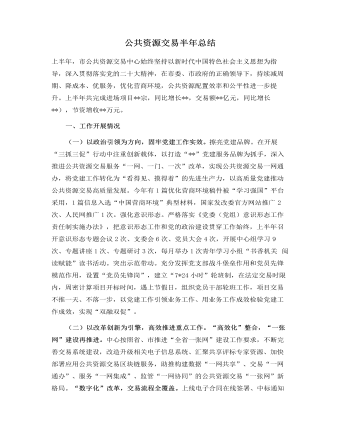
公共资源交易半年总结
二、存在的困难和下一步工作打算建设公共资源交易“全省一张网”是助推构建全国统一大市场的一项具体举措,省上方案明确在我市开展协同监管试点,从全国、全省的普遍情况看,公共资源交易平台整合后,行政监管和处罚权在行业部门,出现了“能管的看不见、看见的管不了”的情况,在相对统一集中的市场中实行分散的行政处罚,执法效率低、成本高,监管和运行存在“两张皮”的问题。面对新任务新要求,**市公共资源交易中心将在推进重点工作上压实压细、在优化营商环境上加压加力、在综合协同监管上先行先试,构建全领域综合监管、跨部门协同监管、大数据智慧监管的一体化智慧监管体系,持续推进公共资源交易市场化改革、数字化转型、法治化保障、规范化运行。
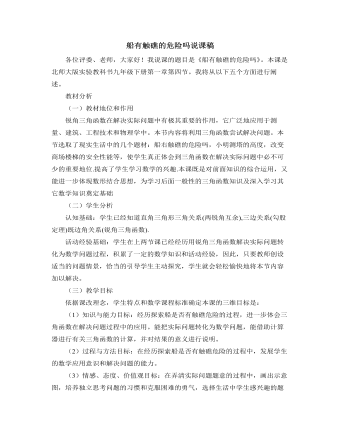
北师大版初中数学九年级下册船有触礁的危险吗说课稿
5、板书设计 §1.4船有触礁的危险吗 一、船布触礁的危险吗 1.根据题意,画出示意图.将实际问题转化为数学问题. 2.用三角函数和方程的思想解决关于直角三角形的问题. 3.解释最后的结果. 二、测量塔高 三、改造楼梯 五布置课后作业: 习题1.6第12 3题 六、设计说明 具有现实意义和挑战性的内容的设计,激发学生的学习兴趣,使学生乐学。 开放性实践问题和分层作业的设置,满足每个学生的学习需求,使学生愿学。 多样的学习方式和适时引导,提高学生的学习质量,使学生能学。 背景多样,层层递进,适时反思,发展学生的数学思维能力,使学生活学。 当学生乐学、愿学、能学、活学时,就将学会学习,将学习当成乐趣,作为生命中不可或缺的部分,也为学生终生学习奠定良好的基础。
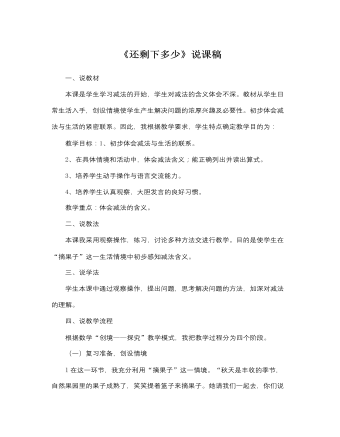
北师大版小学数学一年级上册《还剩下多少》说课稿
教学目标:1、初步体会减法与生活的联系。2、在具体情境和活动中,体会减法含义;能正确列出并读出算式。3、培养学生动手操作与语言交流能力。4、培养学生认真观察,大胆发言的良好习惯。教学重点:体会减法的含义。二、说教法本课我采用观察操作,练习,讨论多种方法交进行教学。目的是使学生在“摘果子”这一生活情境中初步感知减法含义。三、说学法学生本课中通过观察操作,提出问题,思考解决问题的方法,加深对减法的理解。四、说教学流程根据数学“创境——探究”教学模式,我把教学过程分为四个阶段。(一)复习准备,创设情境l在这一环节,我充分利用“摘果子”这一情境。“秋天是丰收的季节,自然果园里的果子成熟了,笑笑提着篮子来摘果子。她请我们一起去,你们说好吗?那我们出发吧!这样学生的好奇心一下子被调动起来渡到第二阶段。
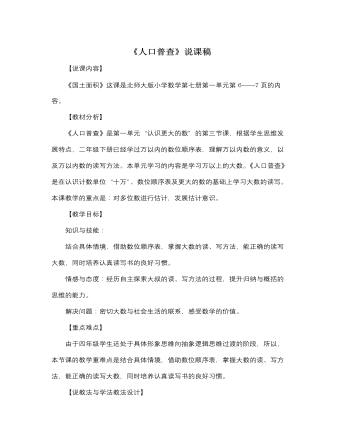
北师大版小学数学四年级上册《人口普查》说课稿
【说课内容】《国土面积》这课是北师大版小学数学第七册第一单元第6——7页的内容。【教材分析】《人口普查》是第一单元“认识更大的数”的第三节课,根据学生思维发展特点,二年级下册已经学过万以内的数位顺序表,理解万以内数的意义,以及万以内数的读写方法。本单元学习的内容是学习万以上的大数。《人口普查》是在认识计数单位“十万”、数位顺序表及更大的数的基础上学习大数的读写。本课教学的重点是:对多位数进行估计,发展估计意识。【教学目标】知识与技能:结合具体情境,借助数位顺序表,掌握大数的读、写方法,能正确的读写大数,同时培养认真读写书的良好习惯。情感与态度:经历自主探索大叔的读、写方法的过程,提升归纳与概括的思维的能力。
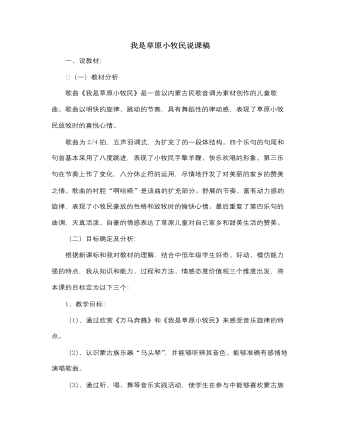
人音版小学音乐三年级上册我是草原小牧民说课稿
4、读歌词:老师带领同学有感情的朗读两边歌词。5、解决难点:二分音符和附点四分音符的节奏练习。6、教师范唱歌曲:7、学生演唱歌曲:老师找出学生唱的不准确的地方。8、教师指导学生演唱:通过老师和学生的对比唱来改正学生的错误。9、师生接唱。10、男女生接唱。师:歌词中说到我是草原小牧民,手拿扬鞭多自豪!那么我们在唱这首歌的时候应该用怎样的情绪呢?11、学生齐唱歌曲 :(三)、拓展部分:1、观看课件蒙古族的民俗:师:同学们这是一首蒙古族的民歌,同学们对蒙古族有哪些了解呢?2、欣赏《筷子舞》:师:可以看出蒙古族是一个能歌善舞的民族,让我们一起来欣赏一段具有蒙古族代表的舞蹈《筷子舞》吧!3、师表演筷子舞:师:同学们看老师给你们带来了什么?生:筷子。师:老师还给同学们准备了一段筷子舞想看吗?那就给老师点掌声吧!
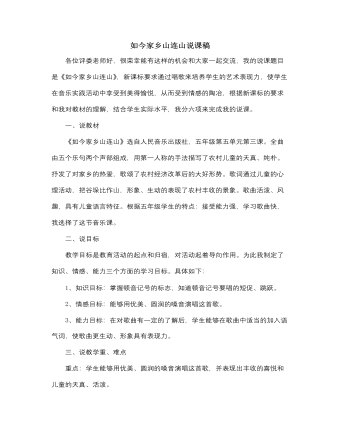
人音版小学音乐三年级上册如今家乡山连山说课稿
3、拓展要求:在学生对歌曲有了一定的了解之后,我会让学生在歌词中适当的地方加入语气词,使歌曲更生动、形象。例如:“妈妈告诉我,家乡没有山”这句歌词,显得有点惋惜和遗憾之情,我觉得用“唉”比较好,下面的就分组讨论。每小组派一个代表唱出自己组里填的语气词。在所有组里的语气词里选一组最好的,确定下来。全班一起演唱,并加上确定的语气词。唱歌比赛:将学生分4个组,一组高声部、一组低声部、一组加语气词、一组加打击乐器(如沙锤、双响筒、碰玲),增强他们的合作意识和合作默契。4、小结在课堂小结时我先安排了学生谈一谈这节课的感想,如:这节课你学到了什么?歌曲中你最喜欢那一句?而且对那些有创意的学生我还及时的发给他们小奖品。在本课的教学中我以表扬和鼓励为主,随时引导学生在音乐活动中开展自评互评和老师的随堂评价,以提高学生的乐感和审美能力。
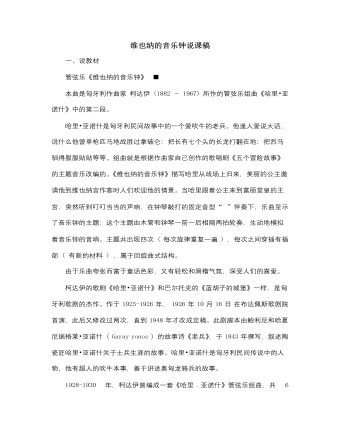
人音版小学音乐三年级上册维也纳的音乐钟说课稿
2. 讲小故事介绍:哈里?亚诺什设计意图:了解音乐创作北京,讲故事的形式很新颖,有趣,能调动学生的积极性。3. 初听乐曲 思考问题:? 在乐曲中你听到钟声了吗?钟声多还是少?还听到其他声音了吗?? 这首乐曲是由一种乐器演奏的,还是由很多乐器演奏的?? 对比上一部作品《灵隐钟声》,这首乐曲给你的感觉是什么?? 你觉得哈里?亚诺什来到了什么地方?森林 战场 王宫设计意图:学生能带着问题有目的的去聆听,然后学生根据问题谈自己的感受3. 介绍作曲家 柯达伊4. 聆听 主题音乐一共重复了几次?每一次都是连着的还是有别的内容?并且把相同的主题音乐用√来表示,不相同的用×来表示。设计意图:方法简单,通俗易懂。学生听辨后能较快作出选择。5. 介绍回旋曲式设计意图:了解曲式结构6. 用小铃铛在主题音调出现时为乐曲伴奏设计意图:用伴奏的形式来表演体现音乐
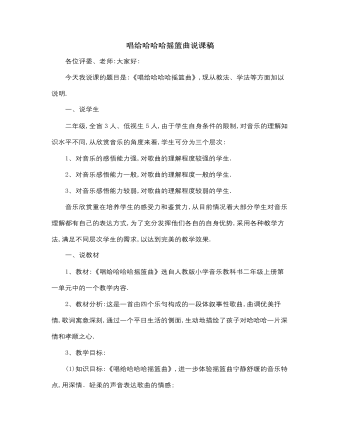
人音版小学音乐三年级上册唱给哈哈哈摇篮曲说课稿
(4)演一演视障生由于生理缺陷,在他们的头脑中很难形成动作形体概念,用情景教学法,使学生身临其境,要求他们不一定按歌曲要求的动作表现,只需要他们把那种对音乐的理解用自己的方式表现出来,边听音乐边表演.通过这样的训练,提高学生的肢体语言能力,同时能大胆发挥想象,做自己对音乐理解的动作,通过动作使其更深刻的理解歌曲.对于低视生让他们通过看课件及对歌曲的理解,创遍简单的舞蹈动作,使其与歌曲的情节相融合,更深刻的体味歌曲内涵.(5)复听歌曲一遍让学生仔细的听乐曲,感受乐曲所带给的独特感受,让他们融入到乐曲中,展开想象,发展他们的空间想象力和创造力,同时提高他们的鉴赏水平.六、课堂小结感谢从小养育我们的父母;感谢一直关心着我们的父母;感谢为我们而操劳的父母……要感谢的太多太多了,就让我们怀着一颗感恩的心,报答我们的父母吧!


